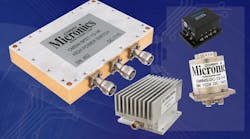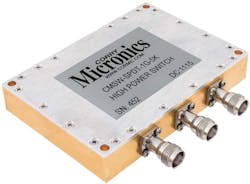Choosing RF Switches for High-Power Applications
Download this article in PDF format.
Switching is crucial in many radio-frequency (RF) applications, whether it’s changing signal pathways through test equipment on a lab bench, or rapidly disconnecting a radar antenna from a transmitter and connecting it to a receiver, and then quickly switching back. As such, it’s important for users to select the correct type of switch for their high-power RF applications.
In a high-power application, the RF signal power can range from a few watts to tens of thousands of watts. Such applications may include switching between multiple antennas, bringing an amplifier online, or connecting to a backup piece of equipment.
Which Switch?
High-power RF switches fall into two basic categories: mechanical and electronic (see figure). In a mechanical switch, a component physically moves through space, closing a contact to enable a signal to flow and opening a contact to stop the signal. A microelectromechanical-systems (MEMS)-based switch does something similar on a smaller scale. Electronic switches, on the other hand, use voltage to change the resistance in the device, blocking the signal from one pathway and moving it along another.
Electronic switches further break down into subcategories, including positive-intrinsic-negative (PIN) diodes and field-effect-transistor (FET) switches. Each type of switch has its own characteristics that determine which application it best fits.
The characteristics that vary among the switches include insertion loss—how much of the signal is lost by running it through the switch. Another is the frequency of the RF signal being handled. Isolation—how much the off position of the switch blocks the signal—differs among switch types. The time it takes for a switch to change pathways can be important as well. There’s also the operational lifetime of the switch—how many times it can change states before it wears out. And, of course, there’s how much power a switch can handle and how that interacts with other aspects of the application, such as frequency.
Insertion Loss
For insertion loss, mechanical switches are clearly superior, with the lowest loss of any switch. The exact amount of loss depends on the frequency of the RF signal in question, but with mechanical switches it’s on the order of 0.1 to 1 decibels (dB). Electronic switches have somewhat more loss, though it can be fairly low, at roughly 0.5 dB to a few decibels. So, if an application requires the lowest possible insertion loss, a mechanical switch might be the best option.
Frequency
The main variable for insertion loss is the frequency of the RF signal; typically, a higher signal frequency leads to higher insertion loss. The different types of switches can all operate to 40 GHz or higher with varying levels of performance. The insertion loss, isolation, and power levels, discussed below, also play a role in a switch’s frequency performance.
Isolation
Isolation refers to the level of attenuation the signal experiences through an off path of the switch. The signal level may be a million times lower, for example, when the path is off versus on—the actual level is a function of frequency. Mechanical switches have the highest isolation (measured in decibels) and, therefore, the best performance. Electronic switches can improve their isolation by accepting higher insertion loss.
Switching Time
For switching time, the mechanical switch, which must physically move a component through space, can accomplish a change in tens of milliseconds. For many applications, that’s more than fast enough. In a lab test setup, where you might want to switch between pieces of equipment once every few days, 100 ms or even 1 second is no time at all, especially if the other choice is spending an hour unplugging and plugging in connectors to manually change the setup. For a broadcaster needing to stay on the air while switching to a backup transmitter, a switching time of a few tenths of a second is perfectly acceptable.
But in a radar or communications system that requires near-instantaneous changes, an electronic switch would be a better choice. FET and MEMS switches operate in the microsecond range, 1,000 times faster than a mechanical switch. PIN diodes, depending on their design, switch in microseconds to nanoseconds.
Lifetime
The ways the switches operate also affect their lifetimes. Again, because mechanical switches involve physical movement, they will wear out faster. The operating lifetime of a mechanical switch is measured in millions of switching cycles. For an application where switching is infrequent, that would provide enough reliability. But a production environment, in which the device must switch among several pieces of test equipment to inspect parts being made, likely could require thousands of cycles per day. Under those conditions, a mechanical switch could wear out and need to be replaced every few months.
A MEMS switch, which also involves mechanical movement, though on a much smaller scale, may last billions of cycles. PIN and FET switches have no moving parts, so their lifetimes are virtually unlimited.
Power
When it comes to power levels, FET switches are on the lower end. They can handle a few tens of watts at reasonably high frequencies. If the application requires a 10-W switch and an 18-GHz signal, for example, a FET will probably provide the best value. MEMS switches are available that can endure reasonably high power at frequencies to 10 GHz with low loss.
But for applications involving many hundreds or thousands of watts, mechanical switches and PIN diodes clearly have the edge. A mechanical switch can handle hundreds of watts with a broad frequency range of up to 40 GHz. The nature of the diode, though, means PIN switches maintain a lower frequency range at higher powers.
The issue has to do with the diode’s capacitance. The intrinsic region of the diode provides high resistance to RF signals when the switch is in the off state. PIN diodes have an inherent capacitance in parallel with the resistive intrinsic region. The capacitance provides an alternate signal path around the intrinsic region and limits the effective impedance of the diode in the off state. As the frequency increases, the effective impedance of the diode decreases, allowing for higher levels of signal to leak through. As signal levels increase, the voltages and currents that the switch must control also ramp up.
The diodes must be able to withstand the increased levels or they will permanently fail. Diodes constructed to handle higher voltage and current also have increased capacitance, making signal leakage higher. The end result is that diodes handling higher power have decreased performance. Diode designers, therefore, must make tradeoffs among the switch’s frequency, speed, power, and isolation.
A PIN diode’s switching speed is also affected by the power levels. The device is switched on and off through the application of a control voltage. At higher power, the voltage from the signal can be enough to turn the switch back on, enabling the signal to pass through when it shouldn’t occur.
The switch can be designed so that the control voltage is higher than the signal voltage to prevent the signal from passing through in those cases. But such a design isn’t practical in all cases, because a very high control voltage requires components that can withstand it, large clearance distances to prevent voltage arcing between components, and more energy for switching. It’s possible to use a control voltage that’s lower than the signal voltage, but the higher the ratio of signal to control voltage, the longer the switching time. The trick is to design a switch with the right balance.
Other Considerations
Another factor in PIN-diode design is something called a video transient. A video transient is a voltage spike that can occur when the control voltage is being applied to change the state of the switch very quickly. Because the control voltage inside the switch is applied directly to the signal path, the spike can appear at the switch’s output or input.
It’s possible to reduce the transient by filtering or by slowing the switching speed, but filtering the spikes also means filtering the signal, thus increasing the insertion loss. Transients are less of an issue with a mechanical switch because the control voltage isn’t applied directly to the signal path.
Plenty of Choices
High-power RF applications can be served by a variety of switches, and the specifics of the applications will determine which switch is the best choice. Mechanical switches can handle the highest powers over a broad range of frequencies. They offer excellent isolation and the lowest insertion loss. On the other hand, their switching times, measured in milliseconds, are among the slowest, and their operating lifetime is limited to millions of cycles.
Among electronic options, FET switches handle tens of watts at reasonably high frequencies. Their insertion loss is low, though not as low as a mechanical switch, but they offer switching times in microseconds and have a virtually unlimited operating lifetime. MEMS switches can deal with similar amounts of power and have switching times comparable to FETs, with an operating lifetime of billions of cycles.
PIN diodes handle very high powers and high frequencies, though when both are present at the same time, tradeoffs are required. Their insertion loss is comparable to FET switches and higher than that of mechanical switches. They offer the fastest switching times, down to the nanosecond range, and offer unlimited lifetimes.
Choosing a switch, then, comes down to which properties are most important for a particular application, whether it’s switching speed, insertion loss, or useful lifetime. By determining which properties are of greatest value and what tradeoffs are acceptable, users can find a switch just right for their high-power RF applications.
Jeff Gibala is Principal Engineer at Corry Micronics.

